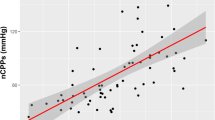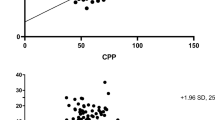Abstract
Background
Brain tissue oxygenation (PbtO2) in traumatic brain injury (TBI) is known to be dependent on cerebral blood flow (CBF) which remains difficult to assess during the very early phase of TBI management. This study evaluates if blood flow velocity measurement with 2D color-coded transcranial Doppler (TCD) can predict cerebral hypoxic episodes in moderate-to-severe TBI measured with a PbtO2 probe.
Methods
This is a prospective observational study of serial TCD measurements to assess blood flow velocity and its association with PbtO2. Measurements were done bilaterally on the middle cerebral artery (MCA) early after the insertion of PbtO2 monitoring, daily for 5 days and during dynamic challenge tests. Physiological parameters affecting PbtO2 and Doppler velocities were collected simultaneously (PaO2, PaCO2, hemoglobin [Hb] level, intracranial pressure, and cerebral perfusion pressure [CPP]).
Results
We enrolled 17 consecutive patients with a total of 85 TCD studies. Using 2D color-coded TCD, signal acquisition was successful in 96% of the cases. Twenty-nine (34%) TCD measures were performed during an episode of cerebral hypoxia (PbtO2 ≤ 20 mmHg). For early episodes of cerebral hypoxia (occurring ≤ 24 h from trauma), all Vmean < 40 cm/s were associated with an ipsilateral PbtO2 ≤ 20 mmHg (positive predictive value 100%). However, when considering all readings over the course of the study, however, we found no correlation between PbtO2 and MCA’s mean blood flow velocity (Vmean). Vmean is also positively correlated with PaCO2, whereas PbtO2 is also correlated with PaO2, CPP, and Hb level.
Conclusions
Early TCD measurements compatible with low CBF (mean velocity < 40 cm/s) detect brain tissue hypoxia early after TBI (≤ 24 h) and could potentially be used as a screening tool before invasive monitoring insertion to help minimize time-sensitive secondary injury. Various factors influence the relationship between Vmean and PbtO2, affecting interpretation of their interaction after 24 h.


Similar content being viewed by others
References
Lu J, Marmarou A, Choi S, Maas A, Murray G, Steyerberg EW, et al. Mortality from traumatic brain injury. Acta Neurochir Suppl. 2005;95:281–5.
Bouzat P, Marques-Vidal P, Zerlauth J-B, Sala N, Suys T, Schoettker P, et al. Accuracy of brain multimodal monitoring to detect cerebral hypoperfusion after traumatic brain injury*. Crit Care Med. 2015;43:445–52.
Gerber LM, Chiu Y-L, Carney N, Härtl R, Ghajar J. Marked reduction in mortality in patients with severe traumatic brain injury. J Neurosurg. 2013;119:1583–90.
Oddo M, Levine JM, Mackenzie L, Frangos S, Feihl F, Kasner SE, et al. Brain hypoxia is associated with short-term outcome after severe traumatic brain injury independent of intracranial hypertension and low cerebral perfusion pressure. Neurosurgery. 2011;69:1037–45.
Obrist WD, Langfitt TW, Jaggi JL, Cruz J, Gennarelli TA. Cerebral blood flow and metabolism in comatose patients with acute head injury. Relationship to intracranial hypertension. J Neurosurg. 1984;61:241–53.
Bouma GJ, Muizelaar JP, Choi SC, Newlon PG, Young HF. Cerebral circulation and metabolism after severe traumatic brain injury: the elusive role of ischemia. J Neurosurg. 1991;75:685–93.
Martin NA, Patwardhan RV, Alexander MJ, Africk CZ, Lee JH, Shalmon E, et al. Characterization of cerebral hemodynamic phases following severe head trauma: hypoperfusion, hyperemia, and vasospasm. J Neurosurg. 1997;87:9–19.
Marion DW, Darby J, Yonas H. Acute regional cerebral blood flow changes caused by severe head injuries. J Neurosurg. 1991;74:407–14.
van Santbrink H, Schouten JW, Steyerberg EW, Avezaat CJJ, Maas AIR. Serial transcranial Doppler measurements in traumatic brain injury with special focus on the early posttraumatic period. Acta Neurochir. 2002;144:1141–9.
Chan KH, Miller JD, Dearden NM, Andrews PJ, Midgley S. The effect of changes in cerebral perfusion pressure upon middle cerebral artery blood flow velocity and jugular bulb venous oxygen saturation after severe brain injury. J Neurosurg. 1992;77:55–61.
Brandi G, Béchir M, Sailer S, Haberthür C, Stocker R, Stover JF. Transcranial color-coded duplex sonography allows to assess cerebral perfusion pressure noninvasively following severe traumatic brain injury. Acta Neurochir. 2010;152:965–72.
Budohoski KP, Zweifel C, Kasprowicz M, Sorrentino E, Diedler J, Brady KM, et al. What comes first? The dynamics of cerebral oxygenation and blood flow in response to changes in arterial pressure and intracranial pressure after head injury. Br J Anaesth. 2012;108:89–99.
Dellazizzo L, Demers SP, Charbonney E, Williams V, Serri K, Albert M, Giguère JF, Laroche M, Williamson D, Bernard F. Minimal PaO2 threshold after traumatic brain injury and clinical utility of a novel brain oxygenation ratio. J Neurosurg. 2018;1:1–9.
Brain Trauma Foundation, American Association of Neurological Surgeons, Congress of Neurological Surgeons. Guidelines for the management of severe traumatic brain injury. J Neurotrauma. 2007. pp. S1–106.
Aaslid R, Markwalder TM, Nornes H. Noninvasive transcranial Doppler ultrasound recording of flow velocity in basal cerebral arteries. J Neurosurg. 1982;57:769–74.
Faul F, Erdfelder E, Lang A-G, Buchner A. G*Power 3: a flexible statistical power analysis program for the social, behavioral, and biomedical sciences. Behav Res Methods. 2007;39:175–91 (2nd ed.).
Maloney-Wilensky E, Gracias V, Itkin A, Hoffman K, Bloom S, Yang W, et al. Brain tissue oxygen and outcome after severe traumatic brain injury: a systematic review. Crit Care Med. 2009;37:2057–63.
Vigué B, Ract C, Benayed M, Zlotine N, Leblanc PE, Samii K, et al. Early SjvO2 monitoring in patients with severe brain trauma. Intensive Care Med. 1999;25:445–51.
Ract C, Le Moigno S, Bruder N, Vigué B. Transcranial Doppler ultrasound goal-directed therapy for the early management of severe traumatic brain injury. Intensive Care Med. 2007;33:645–51.
Tazarourte K, Atchabahian A, Tourtier JP, David JS, Ract C, Savary D, et al. Pre-hospital transcranial Doppler in severe traumatic brain injury: a pilot study. Acta Anaesthesiol Scand. 2011;55:422–8.
Neumann JO, Chambers IR, Citerio G, Enblad P, Gregson BA, Howells T, et al. The use of hyperventilation therapy after traumatic brain injury in Europe: an analysis of the BrainIT database. Intensive Care Med. 2008;34:1676–82.
Menon DK, Coles JP, Gupta AK, Fryer TD, Smielewski P, Chatfield DA, et al. Diffusion limited oxygen delivery following head injury*. Crit Care Med. 2004;32:1384–90.
Veenith TV, Carter EL, Geeraerts T, Grossac J, Newcombe VFJ, Outtrim J, et al. Pathophysiologic mechanisms of cerebral ischemia and diffusion hypoxia in traumatic brain injury. JAMA Neurol. 2016;73:542–50.
Bouzat P, Almeras L, Manhes P, Sanders L, Levrat A, David J-S, et al. Transcranial Doppler to predict neurologic outcome after mild to moderate traumatic brain injury. Anesthesiology. 2016;125:346–54.
Turgeon AF, Lauzier F, Simard J-F, Scales DC, Burns KEA, Moore L, et al. Mortality associated with withdrawal of life-sustaining therapy for patients with severe traumatic brain injury: a Canadian multicentre cohort study. CMAJ. 2011;183:1581–8.
Funding
There was no financial support for this work.
Author information
Authors and Affiliations
Consortia
Contributions
CS, DW, and FB design the study. KS, MA, CO, and EC provided significant feedback on study design. CS collected the data, and FB vouches for the accurateness of it. All authors participated in interpreting the data. CS and FB drafted the article. DW, KS, MA, CO, and EC read the papers and provided critical feedback and suggestions to improve the manuscript. The final manuscript was approved by all authors.
Corresponding author
Ethics declarations
Conflicts of Interest
All authors have nothing to disclose.
Ethical Approval
This work was approved by our local ethics committee.
Additional information
Publisher's Note
Springer Nature remains neutral with regard to jurisdictional claims in published maps and institutional affiliations.
Electronic supplementary material
Below is the link to the electronic supplementary material.
Rights and permissions
About this article
Cite this article
Sokoloff, C., Williamson, D., Serri, K. et al. Clinical Usefulness of Transcranial Doppler as a Screening Tool for Early Cerebral Hypoxic Episodes in Patients with Moderate and Severe Traumatic Brain Injury. Neurocrit Care 32, 486–491 (2020). https://doi.org/10.1007/s12028-019-00763-y
Published:
Issue Date:
DOI: https://doi.org/10.1007/s12028-019-00763-y




